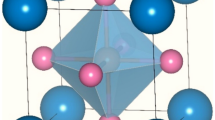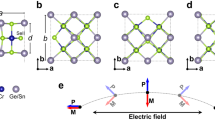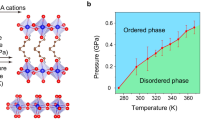Abstract
Multiferroic materials, particularly those possessing simultaneous electric and magnetic orders, offer a platform for design technologies and to study modern physics. Despite the substantial progress and evolution of multiferroics, one priority in the field remains to be the discovery of unexplored materials, especially those offering different mechanisms for controlling electric and magnetic orders1. Here we demonstrate the simultaneous thermal control of electric and magnetic polarizations in quasi-two-dimensional halides (K,Rb)3Mn2Cl7, arising from a polar–antipolar transition, as evidenced using both X-ray and neutron powder diffraction data. Our density functional theory calculations indicate a possible polarization-switching path including a strong coupling between the electric and magnetic orders in our halide materials, suggesting a magnetoelectric coupling and a situation not realized in oxide analogues. We expect our findings to stimulate the exploration of non-oxide multiferroics and magnetoelectrics to open access to alternative mechanisms, beyond conventional electric and magnetic control, for coupling ferroic orders.
This is a preview of subscription content, access via your institution
Access options
Access Nature and 54 other Nature Portfolio journals
Get Nature+, our best-value online-access subscription
$29.99 / 30 days
cancel any time
Subscribe to this journal
Receive 12 print issues and online access
$259.00 per year
only $21.58 per issue
Buy this article
- Purchase on Springer Link
- Instant access to full article PDF
Prices may be subject to local taxes which are calculated during checkout




Similar content being viewed by others
Data availability
Data needed to evaluate the conclusions of this paper are present in the Letter and its Supplementary Information. Additional data are available from the corresponding authors upon request.
References
Spaldin, N. A. Multiferroics beyond electric-field control of magnetism. Proc. R. Soc. A 476, 20190542 (2020).
Wang, J. et al. Epitaxial BiFeO3 multiferroic thin film heterostructures. Science 299, 1719–1722 (2003).
Kimura, T. et al. Magnetic control of ferroelectric polarization. Nature 426, 55–58 (2003).
Bibes, M. & Barthélémy, A. Towards a magnetoelectric memory. Nat. Mater. 7, 425–426 (2008).
Manipatruni, S. et al. Scalable energy-efficient magnetoelectric spin–orbit logic. Nature 565, 35–42 (2019).
Chen, X.-Z. et al. Hybrid magnetoelectric nanowires for nanorobotic applications: fabrication, magnetoelectric coupling, and magnetically assisted in vitro targeted drug delivery. Adv. Mater. 29, 1605458 (2017).
Meier, Q. N. et al. Search for the magnetic monopole at a magnetoelectric surface. Phys. Rev. X 9, 011011 (2019).
Ponet, L. et al. Topologically protected magnetoelectric switching in a multiferroic. Nature 607, 81–85 (2022).
Hill, N. A. Why are there so few magnetic ferroelectrics? J. Phys. Chem. B 104, 6694–6709 (2000).
Pearson, R. G. The second-order Jahn-Teller effect. J. Mol. Struct. THEOCHEM 103, 25–34 (1983).
Hur, N. et al. Electric polarization reversal and memory in a multiferroic material induced by magnetic fields. Nature 429, 392–395 (2004).
Benedek, N. A. & Fennie, C. J. Hybrid improper ferroelectricity: a mechanism for controllable polarization-magnetization coupling. Phys. Rev. Lett. 106, 107204 (2011).
Yoshida, S. et al. Hybrid improper ferroelectricity in (Sr,Ca)3Sn2O7 and beyond: universal relationship between ferroelectric transition temperature and tolerance factor in n = 2 Ruddlesden–Popper phases. J. Am. Chem. Soc. 140, 15690–15700 (2018).
Liu, M. et al. Direct observation of ferroelectricity in Ca3Mn2O7 and its prominent light absorption. Appl. Phys. Lett. 113, 22902 (2018).
Pitcher, M. J. et al. Tilt engineering of spontaneous polarization and magnetization above 300 K in a bulk layered perovskite. Science 347, 420–424 (2015).
Zhu, T. et al. Directed synthesis of a hybrid improper magnetoelectric multiferroic material. Nat. Commun. 12, 4945 (2021).
Horowitz, A., Gazit, D. & Makovsky, J. The growth of K3Mn2Cl7, K4MnCl6 and CsMn4Cl9 from non-stoichiometric melts. J. Cryst. Growth 51, 489–492 (1981).
Moriya, T. Anisotropic superexchange interaction and weak ferromagnetism. Phys. Rev. 120, 91–98 (1960).
Nowadnick, E. A. & Fennie, C. J. Domains and ferroelectric switching pathways in Ca3Ti2O7 from first principles. Phys. Rev. B 94, 104105 (2016).
Li, S. & Birol, T. Suppressing the ferroelectric switching barrier in hybrid improper ferroelectrics. npj Comput. Mater. 6, 168 (2020).
Song, Q. et al. Evidence for a single-layer van der Waals multiferroic. Nature 602, 601–605 (2022).
Scott, J. F. & Blinc, R. Multiferroic magnetoelectric fluorides: why are there so many magnetic ferroelectrics? J. Phys. Condens. Matter 23, 113202 (2011).
Ye, F. et al. Soft antiphase tilt of oxygen octahedra in the hybrid improper multiferroic Ca3Mn1.9Ti0.1O7. Phys. Rev. B 97, 41112 (2018).
Cavalleri, A. et al. Femtosecond structural dynamics in VO2 during an ultrafast solid-solid phase transition. Phys. Rev. Lett. 87, 237401 (2001).
Moya, X., Kar-Narayan, S. & Mathur, N. D. Caloric materials near ferroic phase transitions. Nat. Mater. 13, 439–450 (2014).
Hou, H., Qian, S. & Takeuchi, I. Materials, physics and systems for multicaloric cooling. Nat. Rev. Mater. 7, 633–652 (2022).
Ladd, T. D. et al. Quantum computers. Nature 464, 45–53 (2010).
Alaria, J. et al. Engineered spatial inversion symmetry breaking in an oxide heterostructure built from isosymmetric room-temperature magnetically ordered components. Chem. Sci. 5, 1599–1610 (2014).
Larson, A. C. & von Dreele, R. B. General Structure Analysis System (GSAS). Report No. LAUR 86-748 (Los Alamos National Laboratory, 2004).
Toby, B. H. & von Dreele, R. B. GSAS-II: the genesis of a modern open-source all purpose crystallography software package. J. Appl. Cryst. 46, 544–549 (2013).
Rodríguez-Carvajal, J. Recent advances in magnetic structure determination by neutron powder diffraction. Phys. B Condens. Matter 192, 55–69 (1993).
Campbell, B. J., Stokes, H. T., Tanner, D. E. & Hatch, D. M. ISODISPLACE: a Web-based tool for exploring structural distortions. J. Appl. Cryst. 39, 607–614 (2006).
Perdew, J. P. et al. Restoring the density-gradient expansion for exchange in solids and surfaces. Phys. Rev. Lett. 100, 136406 (2008).
Kresse, G. & Furthmüller, J. Efficient iterative schemes for ab initio total-energy calculations using a plane-wave basis set. Phys. Rev. B 54, 11169–11186 (1996).
Blöchl, P. E. Projector augmented-wave method. Phys. Rev. B 50, 17953–17979 (1994).
Meyer, B. & Vanderbilt, D. Ab initio study of ferroelectric domain walls in PbTiO3. Phys. Rev. B 65, 104111 (2002).
King-Smith, R. D. & Vanderbilt, D. Theory of polarization of crystalline solids. Phys. Rev. B 47, 1651–1654 (1993).
Liechtenstein, A. I., Anisimov, V. I. & Zaanen, J. Density-functional theory and strong interactions: orbital ordering in Mott-Hubbard insulators. Phys. Rev. B 52, R5467–R5470 (1995).
Xiang, H. J., Kan, E. J., Wei, S.-H., Whangbo, M.-H. & Gong, X. G. Predicting the spin-lattice order of frustrated systems from first principles. Phys. Rev. B 84, 224429 (2011).
Hukushima, K. & Nemoto, K. Exchange Monte Carlo method and application to spin glass simulations. J. Phys. Soc. Jpn 65, 1604–1608 (1996).
Acknowledgements
We thank A. Kaminaka from Tohoku University for sample preparation and S. Kawaguchi and S. Kobayashi from SPring-8, JASRI, for assistance in collecting the SXRD data (2020A0822). The NPD experiments were performed at J-Parc BL09 SPICA beamline (2019S10) and JRR-3 HERMES beamline (22602). T.Z. acknowledges the project of university-industrial collaboration (Kyoto University-Sumitomo Chemical), Japan. H.K. and T.Z. acknowledge the JSPS Core-to-Core Program (JPJSCCA202000004), and JSPS Grant-in-Aid for Specially Promoted Research ‘Hydrogen Ion Ceramics’ (JP22H04914). T.Z. and S.K. acknowledge the GIMRT Program of the Institute for Materials Research, Tohoku University (202109-RDKGE-0104). X.-Z.L. and J.M.R. were supported by the National Science Foundation under award no. DMR-2011208. Computational efforts were supported by the National Energy Research Scientific Computing Center (NERSC), a US Department of Energy, Office of Science User Facility, located at Lawrence Berkeley National Laboratory, operated under contract no. DE-AC02-05CH11231, and the Extreme Science and Engineering Discovery Environment (XSEDE), which is supported by NSF (ACI-1548562). T.A. was supported by the JSPS KAKENHI (20K14396). K.F. was supported by the JSPS KAKENHI (JP20K20546 and JP22H01775), the Kazuchika Okura Memorial Foundation, the Nippon Sheet Glass Foundation for Materials Science and Engineering and the Mitsubishi Foundation.
Author information
Authors and Affiliations
Contributions
T.Z., X.-Z.L., J.M.R. and H.K. designed the project. T.Z., S.K. and A.Y. synthesized the samples. X.-Z.L. performed the theoretical calculations. T.Z., Y.N., T.S. and C.T. collected the SXRD and NPD data. T.Z. performed the structural analysis, with comments from Y.N., K.F. and X.-Z.L. T.A. and K.O. performed the physical property measurements. K.F., T.K. and T.T. performed the SHG measurements. T.Z., H.T. and H.-B.L. collected and analysed the magnetization data. T.Z., X.-Z.L., J.M.R. and H.K. wrote the manuscript, with comments from other authors.
Corresponding authors
Ethics declarations
Competing interests
The authors declare no competing interests.
Peer review
Peer review information
Nature Materials thanks the anonymous reviewers for their contribution to the peer review of this work.
Additional information
Publisher’s note Springer Nature remains neutral with regard to jurisdictional claims in published maps and institutional affiliations.
Supplementary information
Supplementary Information
Supplementary Sections 1–12, Figs. 1–33, Tables 1–12 and discussion.
Supplementary Data 1
Optimized computational model 1: A21am space group structure.
Supplementary Data 2
Optimized computational model 2: P42/mnm space group structure.
Supplementary Data 3
Optimized computational model 3: I4/mmm space group structure.
Rights and permissions
Springer Nature or its licensor (e.g. a society or other partner) holds exclusive rights to this article under a publishing agreement with the author(s) or other rightsholder(s); author self-archiving of the accepted manuscript version of this article is solely governed by the terms of such publishing agreement and applicable law.
About this article
Cite this article
Zhu, T., Lu, XZ., Aoyama, T. et al. Thermal multiferroics in all-inorganic quasi-two-dimensional halide perovskites. Nat. Mater. 23, 182–188 (2024). https://doi.org/10.1038/s41563-023-01759-y
Received:
Accepted:
Published:
Issue Date:
DOI: https://doi.org/10.1038/s41563-023-01759-y



